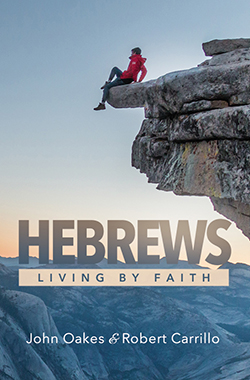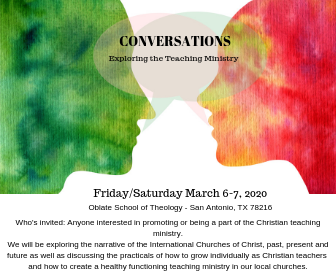EFC Newsletter January, 2020
Hebrews: Living by Faith. A new book published by Dr. John Oakes and Robert Carrillo
We are excited to announce that as of mid-February John Oakes’ new book on Hebrews will become available. He has written the book in concert with Robert Carrillo, former CEO of HOPE Worldwide and evangelist in the Los Angeles International Church of Christ. The book is available for pre-order at www.ipibooks.com. We are including the first part of the intro to the book below as a teaser.
Here is a direct link to purchase a copy of the book:
https://ipibooks.ecwid.com/#!/Hebrews%E2%80%94Living-By-Faith/p/168762906/category=18671191
New Material
There is plenty of new material available at Evidenceforchristianity. I just finished a series of six lessons on Ezekiel. Audio, notes and power points are available at the web site. In addition, a class on James and a class I taught for the Los Angeles School of Missions and Ministry on Genesis are available as well. You will find a paper on the Mother Goddess cult/religion at the site. This is a movement that has been growing on our campuses.
Conversations: A Biblical Teacher’s Conference
We at ARS are helping to sponsor a conference for Bible teachers in San Antonio March 5-7, 2020. Initially, registration was only open for the conference, which is on Friday and Saturday. Speakers include Douglas Jacoby, Gordon Ferguson, Ed and Deb Anton, Kay McKean, Steve Kinnard and many more. The link to register for the conference is https://www.icocteachersconference.com/
More recently, we have been able to open the Bible teacher’s forum, which will include a program on Thursday and Friday AM. Here we will be listening to a wide variety of speakers to help us look at the Restoration Movement in order to find a narrative as we move forward. Speakers include John Mark Hicks, Naomi Walters, Evertt Huffard, Mark Love and many more. Registration is available at https://www.icocteachersforum.com/
John Oakes
Hebrews: Living by Faith Introduction
The book of Hebrews is truly one of God’s great gifts to the Church. Beautifully composed, it is distinct from any of the letters or Gospels in the New Testament. In reality, it is neither a letter nor a gospel. If read aloud, as was originally intended by the author, it flows much more like a sermon than like a letter to particular hearers or a historical account such as the Gospels and Acts. It combines some of the most eloquent writing in the New Testament with deeply profound theological and Christological statements.
For both of us, it is our favorite book in the Bible, simply because it has done more to shape us into the persons we are today than any other. There are two qualities that make Hebrews stand out for us. First is its presentation of Jesus Christ. Hebrews dramatically reveals the humanity of Jesus, while at the same time powerfully arguing for his greatness and deity. No other biblical book paints so clear a picture of Jesus as a man of human weakness and at the same time as our mighty God. In the book of Hebrews, we see Jesus as the great high priest through whom we gain unlimited access to God. Hebrews presents the most exalted view of our Savior found in Scripture. And as Jesus said, “I, when I am lifted up from the earth, will draw all people to myself.” (John 12:32) If we want people to come to Christ for salvation, what can we do that is more effective than to lift Jesus up? This is what the book of Hebrews does.
The other reason we love this book with an unbridled passion is that, of all the books in the New Testament, it is the one that connects the New and Old Testaments most effectively. There is no close rival for second place in this respect. It is from Hebrews that we learn to interpret the items in the tabernacle, the laws, the sacrifices, the priesthood, the covenants, the festivals—indeed, nearly everything we find in the Hebrew Bible as types, prefigures and foreshadows of what we have in Christ. In Romans we learnthat the Mosaic covenant was a foster parent for the Jews, admonishing them and reminding them how completely inadequate they were to have a relationship with God based on their own righteousness. In Hebrews we see how wonderful a foster parent and what a magnificent teacher the Old Testament was.
Another way to think of Hebrews is as the fifth gospel. The gospels are Matthew, Mark, Luke, John and Hebrews. Of course, it is not a story of Jesus’ ministry, and it does not include an account of the death, burial and resurrection of our Lord, so it is not a classical gospel in that sense. But in another sense, a gospel is a revealed picture of Jesus. Each of the four classical Gospels gives us a unique picture of the Christ. Hebrews gives us a fifth. Matthew reveals Jesus as the one who fulfills the prophecies of the Old Testament and who satisfies and completes the law of Moses. Mark reveals Jesus as the one who powerfully announced the coming of the kingdom of God. Luke reveals him as the one who brings salvation even in this life, especially for the poor, the outcast, women and Gentiles. John reveals Jesus as the Son of God through his miracles and his I AM statements. Of course, Jesus is all of these things, and Hebrews gives us a yet another revelation of him. In Hebrews Jesus is the great high priest of God for all of his people. It is only in Hebrews that we see him as such. Of all the qualities of Jesus brought out in the book, it is his role as high priest of a new covenant that the Hebrew writer places at the forefront.
Although Hebrews gives us a picture of Jesus’ unrivaled majesty and brings the Old and New Testaments together more than any other book does, neither of these was the reason it was written in the first place. The writer proclaims the purpose of the Book of Hebrews to us: it was given as a word of paraklesis, “exhortation” (Hebrews 13:22), a word that is also translated “encouragement.” The book was written to exhort or encourage us. Hebrews certainly lives up to this statement, with its five warnings and five encouragements. The book is a resounding call for believers to strengthen their faith by focusing on Jesus, the great man, prophet, Messiah and God.
Strengthen your feeble arms and weak knees. “Make level paths for your feet.”… Make every effort to live in peace with all men…be holy…. See to it that no one falls short of the grace of God and that no bitter root grows up…. See that no one is sexually immoral, or is godless like Esau. (Hebrews 12:12–16).
If we heed the call of the writer of Hebrews to fix our eyes on Jesus, the beginner and completer of our faith, and if we accept wholeheartedly the exhortations found in this marvelous book, there is no doubt whatsoever that we will realize the goal envisioned in it, which is to enter the eternal Sabbath rest God has prepared for his people. We are about to embark on a journey from which we will emerge as changed people. We cannot delve deeply into Hebrews without being transformed by this most amazing book. The power for our transformation is simple: it comes from the person Jesus Christ. How, then, does the writer present our Redeemer and Creator Jesus to us? And how does he turn this picture into a word of encouragement through which, if we accept it, we can be assured of our salvation? Before delving into this and before receiving the admonition to faithful living God has in store for us, let us consider the background, the theme, the audience and the style particular to the book of Hebrews.














































